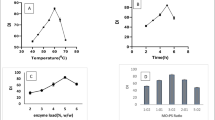Abstract
To manufacture beef tallow (BT)-based shortening and margarine with a reduced tendency to developing sandiness, BT/canola oil (CaO) blend (80:20 w/w), selected from the BT and CaO blends mixed in different ratios from 60:40 to 85:15 with 5% increments, was subjected to chemical interesterification (CIE) with sodium methoxide as the catalyst. The interesterified products were compared with the starting mixture in terms of solid fat content (SFC), and contents of high-melting point 1,3-disaturated long-chain fatty acid 2-monounsaturated long-chain fatty acid triacylglycerols (SUS TAGs) including 1,3-distearoyl-2-oleoyl-glycerol (StOSt), 1,3-dipalmitoy-2-oleoyl-glycerol (POP), and 1-palmitoyl-2-oleoyl-3-stearoyl-glycerol (POSt). Under the selected conditions: 60 °C, 0.6% CH3ONa, 90 min, the CIE product had a SFC profile that meets suggested bakery fat requirements, besides a content of SUS TAGs which is 22.14% lower than that of the non-interesterified blend. Also the fat produced had stable β′ polymorphs, crystal morphology, crystal sizes (<20 μm), and could resist temperature fluctuations. The CIE product obtained herein has an increased potential for manufacturing bakery shortenings and margarines with reduced graininess formation, increasing the possibilities for the commercial use of BT and CaO.



Similar content being viewed by others
References
Jin Q, Gao H, Shan L, Liu Y, Wang X (2007) Study on grainy crystals in edible beef tallow shortening. Food Res Int 40:909–914
Ishikawa H, Mizuguchi T, Kondo S (1980) Studies on granular crystals growing in palm oil. J Jpn Oil Chem Soc 29:235–242
Watanabe A, Tashima I, Matsuzakj N, Kurashige J, Sato K (1992) On the formation of granular crystals in fat blends containing palm oil. J Am Oil Chem Soc 69:1077–1080
Miura S, Konishi H (2001) Crystallization behavior of 1,3-dipalmitoyl-2-oleoyl-glycerol and 1-palmitoyl-2,3-dioleoylglycerol. Eur J Lipid Sci Technol 103:804–809
Tanaka L, Miura S, Yoshioka T (2007) Formation of granular crystals in margarine with excess amount of palm oil. J Am Oil Chem Soc 84:421–426
Norizzah AR, Chong CL, Cheow CS, Zaliha O (2004) Effects of chemical interesterification on physicochemical properties of palm stearin and palm kernel olein blends. Food Chem 86:229–235
Chu BS, Ghazali HM, Lai OM, Cheman YB, Yusof S (2002) Physical and chemical properties of a lipase–transesterified palm stearin/palm kernel olein blend and its isopropanol-solid and high melting triacylglycerol fractions. Food Chem 76:155–164
Foglia TA, Petruso K, Feairheller SH (1993) Enzymatic interesterification of tallow–sunflower oil mixtures. J Am Oil Chem Soc 70:281–285
Rodríguez A, Castro E, Salinas MC, López R, Miranda M (2001) Interesterification of tallow and sunflower oil. J Am Oil Chem Soc 78:431–436
Lutton E, Mallery M, Burgers J (1962) Interesterification of lard. J Am Oil Chem Soc 39:233–235
Laning S (1985) Chemical interesterification of palm, palm kernel and coconut oils. J Am Oil Chem Soc 62:400–407
Firestone D (2004) Official methods and recommended practices of the American Oil Chemists’ Society, 5th edn. American Oil Chemists’ Society, Champaign
Marangoni AG, Rousseau D (1995) Engineering triacylglycerols: the role of interesterification. Trends Food Sci Tech 6:329–335
Ribeiro APB, Grimaldi R, Gioielli LA, Gonçalves LAG (2009) Zero trans fats from soybean oil and fully hydrogenated soybean oil: physico–chemical properties and food applications. Food Res Int 42:401–410
Chen CW, Chong CW, Ghazali HM, Lai OM (2007) Interpretation of triacylglycerol profiles of palm oil, palm kernel oil and their binary blends. Food Chem 100:178–191
List GR, Warner K, Pintauro P, Gil M (2007) Low-trans shortening and spread fats produced by electrochemical hydrogenation. J Am Oil Chem Soc 84:497–501
Aguedo M, Hanon E, Danthine S, Paquot M, Lognay G, Thomas A, Vandenbol M, Thonart P, Wathelet JP, Blecker C (2008) Enrichment of anhydrous milk fat in polyunsaturated fatty acid residues from linseed and rapeseed oils through enzymatic interesterification. J Agric Food Chem 56:1757–1765
Byrdwell WC (2001) Atmospheric pressure chemical ionization mass spectrometry for analysis of lipids. Lipids 36:327–346
Heidi L, Suomela J-P, Kallio H (2007) Quantification of triacylglycerol regioisomers in oils and fat using different mass spectrometric and liquid chromatographic methods. Rapid Commun Mass Spectrom 21:2361–2373
Lee JH, Akoh CC, Lee K-T (2008) Physical properties of trans-free bakery shortening produced by lipase-catalyzed interesterification. J Am Oil Chem Soc 85:1–11
Acknowledgments
This work was supported by the National High Technology Research and Development Program (863 Program) of China (Contract No. 2010AA101506). The authors gratefully acknowledge Mr. Tao Guan Jun of State Key Laboratory of Food Science and Technology, Jiangnan University, for technical assistance during the HPLC/APCI-MS analysis.
Author information
Authors and Affiliations
Corresponding author
About this article
Cite this article
Meng, Z., Liu, Y., Shan, L. et al. Reduction of Graininess Formation in Beef Tallow-Based Plastic Fats by Chemical Interesterification of Beef Tallow and Canola Oil. J Am Oil Chem Soc 87, 1435–1442 (2010). https://doi.org/10.1007/s11746-010-1627-5
Received:
Accepted:
Published:
Issue Date:
DOI: https://doi.org/10.1007/s11746-010-1627-5




